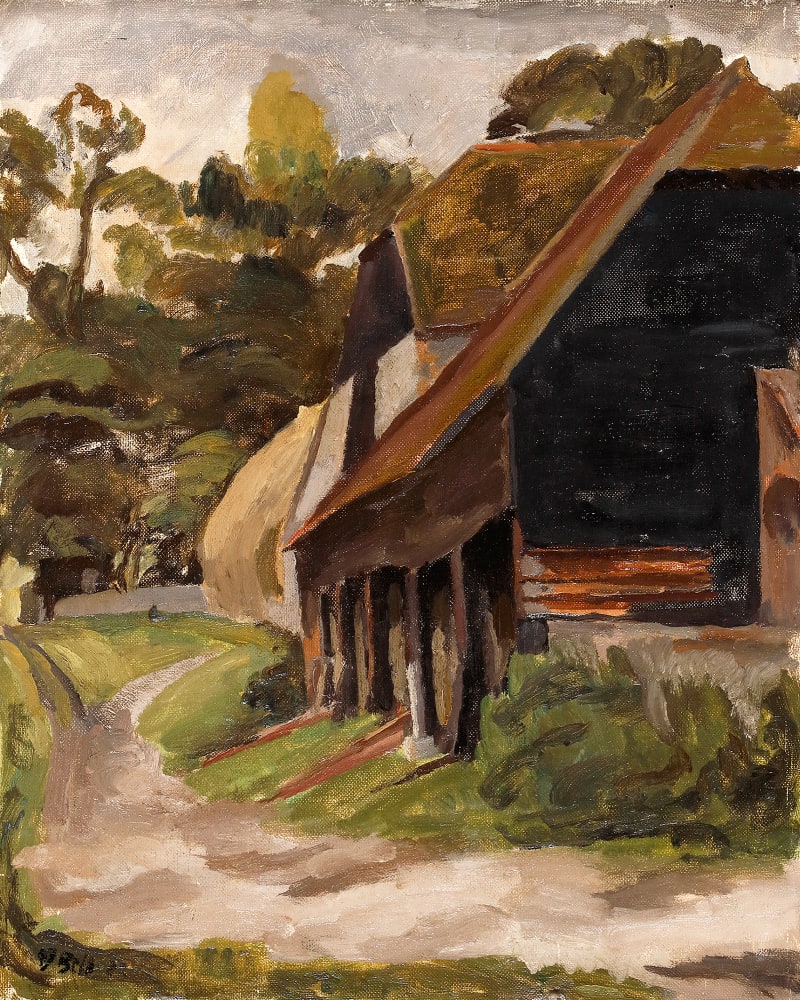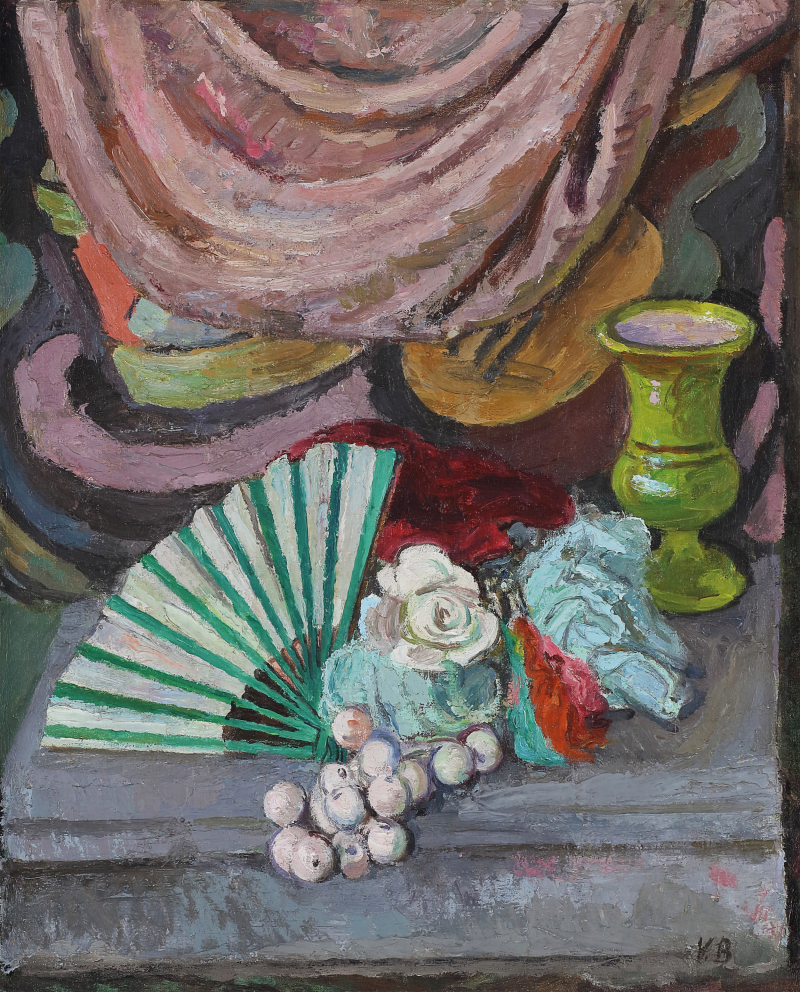Sold out
Previous

Vanessa Bell
(1879-1961) Self Portraitc. 1952
Oil on canvas
16 1/2 x 12 1/4 in. (42 x 31 cm)
Provenance
Possibly Adams Gallery, London, 1961, where purchased by Cyril Connolly;
Christie's, London, 1 July 1993, lot 22;
Christie's, London, 11 March 1994, lot 117;
Private Collection, U.K.
Christie's, London, 1 July 1993, lot 22;
Christie's, London, 11 March 1994, lot 117;
Private Collection, U.K.
Literature
Sarah Milroy & Ian A.C. Dejardin, Vanessa Bell (London: Bloomsbury, Philip Wilson Publishers, 2017) pp.178-9;
Richard Shone, The Art of Bloomsbury, Roger Fry, Vanessa Bell and Duncan Grant, (London: Tate Gallery Publishing, 1999) p.236.
Richard Shone, The Art of Bloomsbury, Roger Fry, Vanessa Bell and Duncan Grant, (London: Tate Gallery Publishing, 1999) p.236.
Exhibitions
London, Adams Gallery, Exhibition of Paintings by Vanessa Bell, October 1961;
London, Belgrave Gallery, British Post-Impressionist and Moderns, February-March 1985;
London, National Portrait Gallery, Mirror, Mirror: Self Portraits by Women Artists, 12 September 2001-20 January 2002; travelled to Leeds, Leeds City Art Gallery, 18 April-9 June, Bath, Victoria Art Gallery, 22 June-1 August and Canterbury, Royal Museum & Art Gallery, 7 September-2 November 2002;
London, Dulwich Picture Gallery, Vanessa Bell, 8 February-4 June 2017.
London, Belgrave Gallery, British Post-Impressionist and Moderns, February-March 1985;
London, National Portrait Gallery, Mirror, Mirror: Self Portraits by Women Artists, 12 September 2001-20 January 2002; travelled to Leeds, Leeds City Art Gallery, 18 April-9 June, Bath, Victoria Art Gallery, 22 June-1 August and Canterbury, Royal Museum & Art Gallery, 7 September-2 November 2002;
London, Dulwich Picture Gallery, Vanessa Bell, 8 February-4 June 2017.
Sold
Painted in her attic studio at Charleston, where Bell reportedly felt most profoundly herself, the present self-portrait is indicative of the artist’s gradual retreat into a more secluded lifestyle during her later years.[1] It is one of only six self-portraits painted by Bell and is one of her most insightful and introspective later works. Clasping her fist around a collection of paint brushes, poised above a plate repurposed as a palette, the present portrait can be interpreted as a platform for self-representation. Bell presents herself as the subject of her own self-reflexive artistic independence and personal integrity.
In 1912, Bell’s work was included in the Second Post-Impressionist Exhibition, organised by critic Roger Fry, which was a hallmark event for the development of modern art in Britain. A year later, along with Fry and fellow painter Duncan Grant, Bell founded the Omega Workshops, a cooperative for the decorative arts which emphasised bold colours and simple designs for textiles, pottery, clothing...
In 1912, Bell’s work was included in the Second Post-Impressionist Exhibition, organised by critic Roger Fry, which was a hallmark event for the development of modern art in Britain. A year later, along with Fry and fellow painter Duncan Grant, Bell founded the Omega Workshops, a cooperative for the decorative arts which emphasised bold colours and simple designs for textiles, pottery, clothing...
| Painted in her attic studio at Charleston, where Bell reportedly felt most profoundly herself, the present self-portrait is indicative of the artist’s gradual retreat into a more secluded lifestyle during her later years.[1] It is one of only six self-portraits painted by Bell and is one of her most insightful and introspective later works. Clasping her fist around a collection of paint brushes, poised above a plate repurposed as a palette, the present portrait can be interpreted as a platform for self-representation. Bell presents herself as the subject of her own self-reflexive artistic independence and personal integrity. In 1912, Bell’s work was included in the Second Post-Impressionist Exhibition, organised by critic Roger Fry, which was a hallmark event for the development of modern art in Britain. A year later, along with Fry and fellow painter Duncan Grant, Bell founded the Omega Workshops, a cooperative for the decorative arts which emphasised bold colours and simple designs for textiles, pottery, clothing and furniture. Bell was particularly gifted in textile design and soon became known for her interior designs. At the height of war and with the introduction of conscription in March 1916, Bell moved to Charleston House near Lewes, East Sussex with her partner Duncan Grant and his lover, David Garnett. Charleston became a hub of artistic and literary creativity for the Bloomsbury circle. Bell and Grant created elaborate interiors at Charleston. They painted frescoes on the walls and doors, hung their own paintings and drawings throughout the house, and brought Omega textiles and pottery into their home. Visiting the house today makes it clear what a place of colour and creativity it was whilst Bell was living there. By the time this portrait was painted, Bell had become a colourist, relishing the opportunity to capture simple natural beauty using refined techniques which differ from her bold, often linear works of the early 20th Century. The influence of the Omega Workshops is arguably evident in the present self-portrait, through the geometric shapes – the fabric covering the chair Bell had designed for Alan Wolton’s company in the early 1930s.[2]. An important modern development of specifically female portraiture is the portrayal of the artist’s studio.[3] Retrospectively, Bell’s present self-portrait in her studio might be read somewhat as a visual manifestation of the assertions made in Virginia Woolf’s A Room of One’s Own; ‘A woman must have money and a room of her own if she is to write fiction.’[4] Indeed, Bell’s attic studio was immensely important to her – Richard Shone observes that ‘the top studio was where she was most deeply herself’.[5] Although small in scale, this self-portrait commands significant consideration. Richard Shone befittingly refers to Bell’s later self-portraits as; ‘Resigned, yet resilient, her remoteness is tempered by her permitting us to see it so directly.’[6] Her use of vigorous, postimpressionistic brushstrokes blur the details of her facial features; the resulting anonymity allows her to blend into the idiom of an artist at work in her studio. Even throughout her final years, Bell asserts her artistic talent and pioneering legacy. [1] R. Shone ‘Vanessa Bell’s Late Self-Portraits’, in (eds. Milroy & I. Dejardin) Vanessa Bell (London: Bloomsbury, Philip Wilson Publishers, 2017) p.183. [2] R. Shone ‘Vanessa Bell’s Late Self-Portraits’, in (eds. Milroy & I. Dejardin) Vanessa Bell (London: Bloomsbury, Philip Wilson Publishers, 2017) p.179. [3] F. Borzello, Seeing Ourselves: Women’s Self-Portraits (London: Thames & Hudson Ltd, 2016). [4] V. Woolf, A Room of One’s Own (London: 1929). [5] R. Shone ‘Vanessa Bell’s Late Self-Portraits’, in (eds. Milroy & I. Dejardin) Vanessa Bell (London: Bloomsbury, Philip Wilson Publishers, 2017) p.183. [6] R. Shone ‘Vanessa Bell’s Late Self-Portraits’, in (eds. Milroy & I. Dejardin) Vanessa Bell (London: Bloomsbury, Philip Wilson Publishers, 2017) p.183. |







